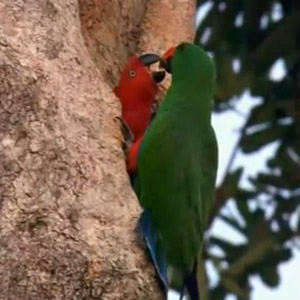Magazine | Analyses
Des perroquets pas comme les autres

Grands Éclectus (Eclectus roratus) femelle et mâle, Australie.Source : image extraite d’une vidéo postée par Slayer2878 / KPBS
Introduction
Les perroquets du genre Eclectus sont originaux à plusieurs points de vue : les femelles sont bien plus colorées que les mâles (on parle de dichromatisme sexuel inversé), au point qu’on a longtemps cru qu’ils appartenaient à des espèces différentes, leur système de reproduction est curieux, et les femelles auraient la capacité de choisir le sexe de leurs poussins. Ces caractéristiques seraient principalement liées à la forte compétition existant chez les deux sexes pour la recherche des partenaires pour s’accoupler et des cavités pour nicher.
Abstract
The Eclectus parrots are different from the others members of the Psittacidea family because of their reversed plumage coloration (also called reversed sexual dichromatism) which is not associated with reversed sex roles, their system of shared and cooperative breeding (In contrast to most parrots which are monogamous) and their apparent ability to manipulate the sex of their young. All of these distinctive traits appear to be related to the lack of cavities in big trees for nesting in the rainforest landscape; this fact leads to high competition among both sexes* in search of nesting sites as well as for mates.
Poursuivez la lecture de cet article, en vous abonnant dès maintenant !
Découvrez les Archives d’Ornithomedia.com
Pour seulement 10,00 €TTC/an (ou 6,00 € les 6 mois)
Profitez de plusieurs centaines d’articles en accès illimité et sans aucun engagement.
Compléments
Ouvrages recommandés
- Birds of Australia de Ken Simpson et Nicolas
- Eclectus Parrots: Everything About Purchase, Care, Feeding, and Housing de Katy McElroy
- Bird Coloration: Function And Evolution de Geoffrey E. Hill, Kevin J. McGraw
Sources
- Robert Heinsohn, PhD (2008). Ecology and Evolution of the Enigmatic Eclectus Parrot (Eclectus roratus). Journal of Avian Medicine and Surgery 22(2):146–150. http://people.anu.edu.au
- Roland Seitre (2004). Eclectus, perroquets aberrants. Oiseaux exotiques. http://seitre.chez-alice.fr/CDE/Eclectus.pdf
- Victoria Gill (2009). Finches choose sex of offspring. BBC. Date : 20/03. http://news.bbc.co.uk/2/hi/science/nature/7953467.stm
- Geoffrey E. Hill et Kevin J. McGraw (2006). Bird Coloration: Mechanisms And Measurements. Harvard University Press
- Robert Heinsohn, Sarah Legge (2003). Breeding biology of the reverse-dichromatic, co-operative parrot Eclectus roratus. Journal of Zoology. Volume 259, Issue 2, pages 197–208. http://onlinelibrary.wiley.com/doi/10.1017/S0952836902003138/abstract
- Robert Heinsohn, Sarah Legge et John A. Endler (2005). Extreme Reversed Sexual Dichromatism in a Bird Without Sex Role Reversal. Science. Vol. 309 no. 5734. Pages 617-619. http://www.sciencemag.org/content/309/5734/617.short
- Robert Heinsohn (2008). Animal Behaviour. Volume 76, Issue 1. Juillet. Pages 97–103. http://www.sciencedirect.com/science/article/pii/S0003347208001206




Aucun commentaire sur ce sujet
Participer à la discussion !